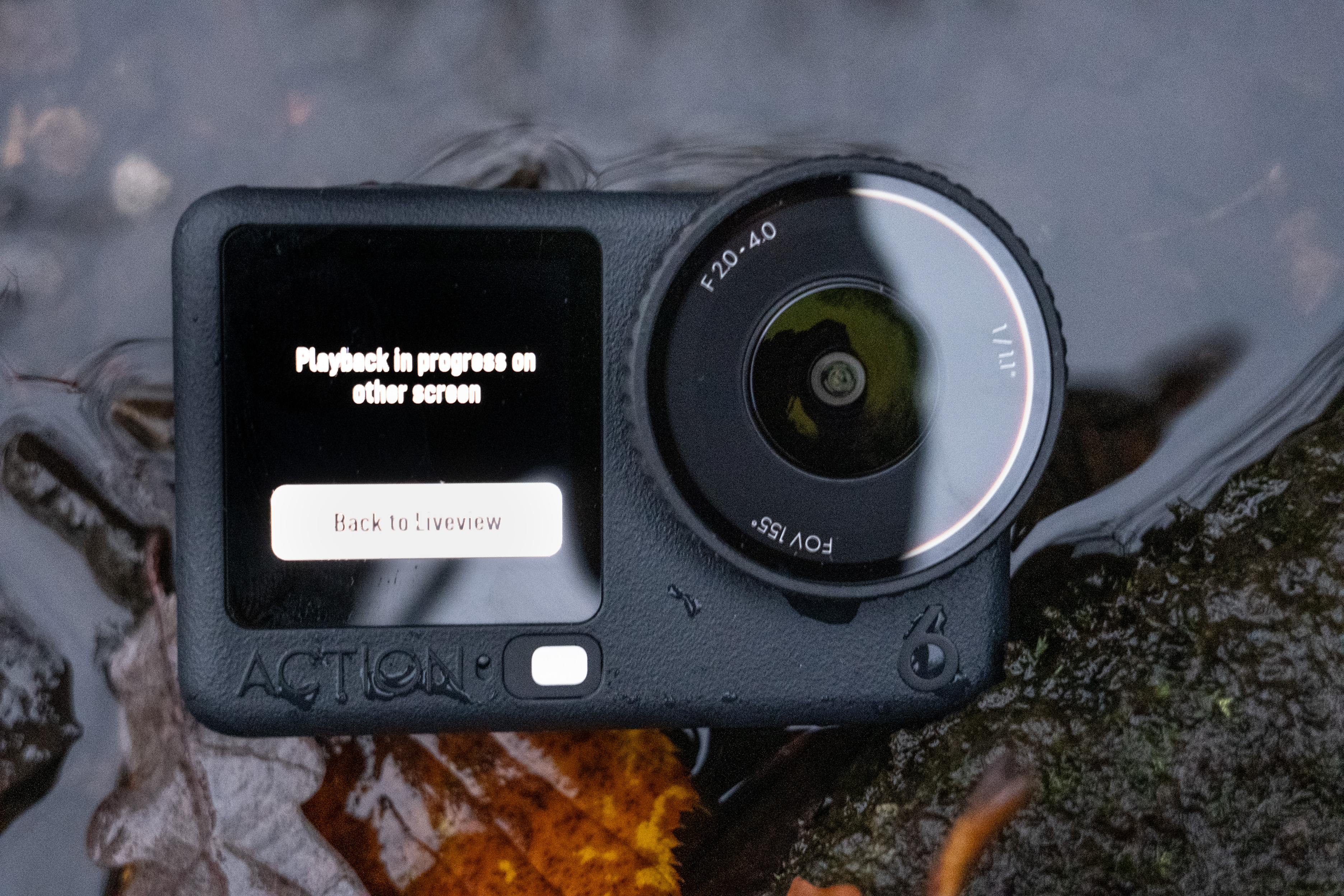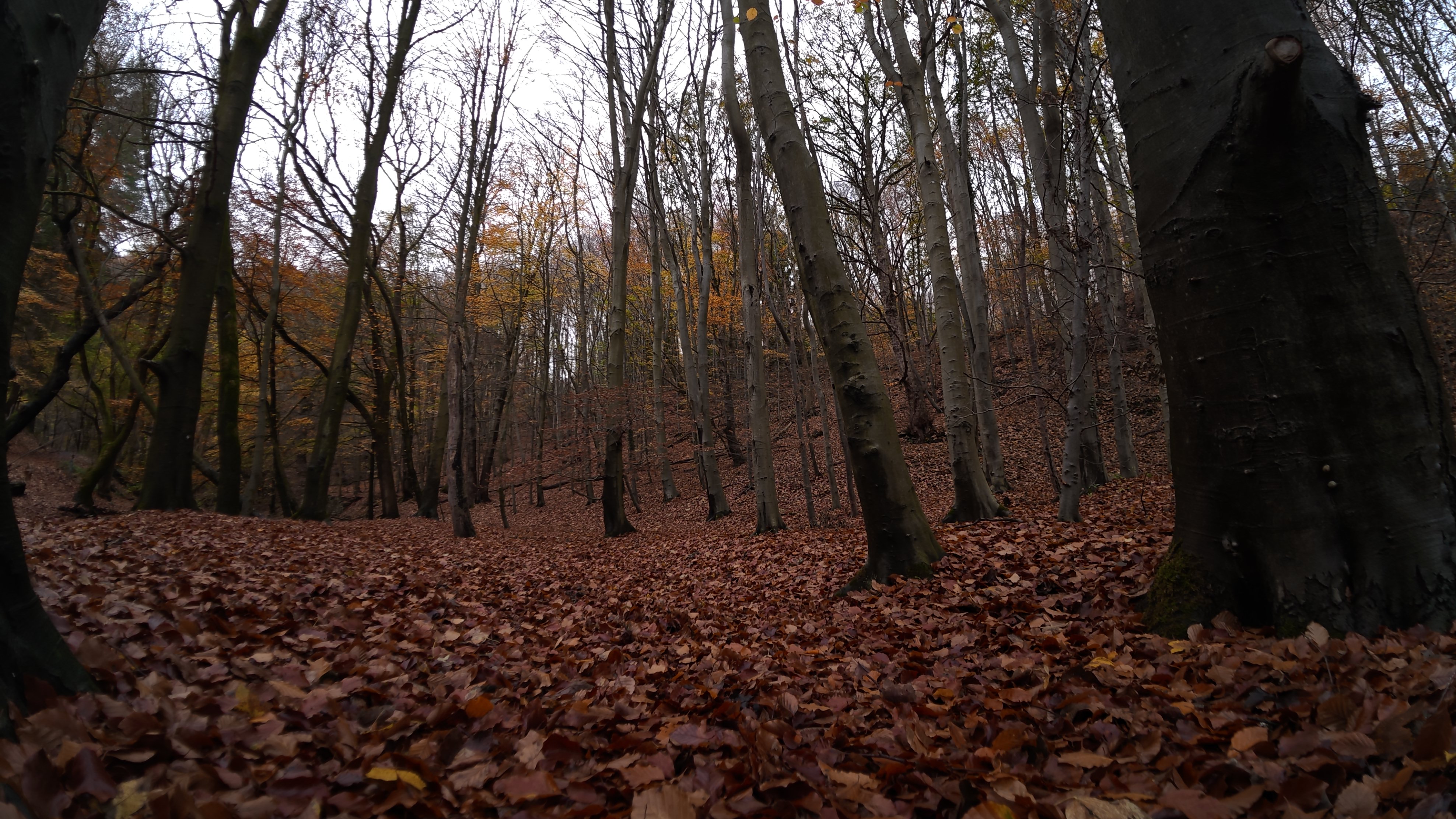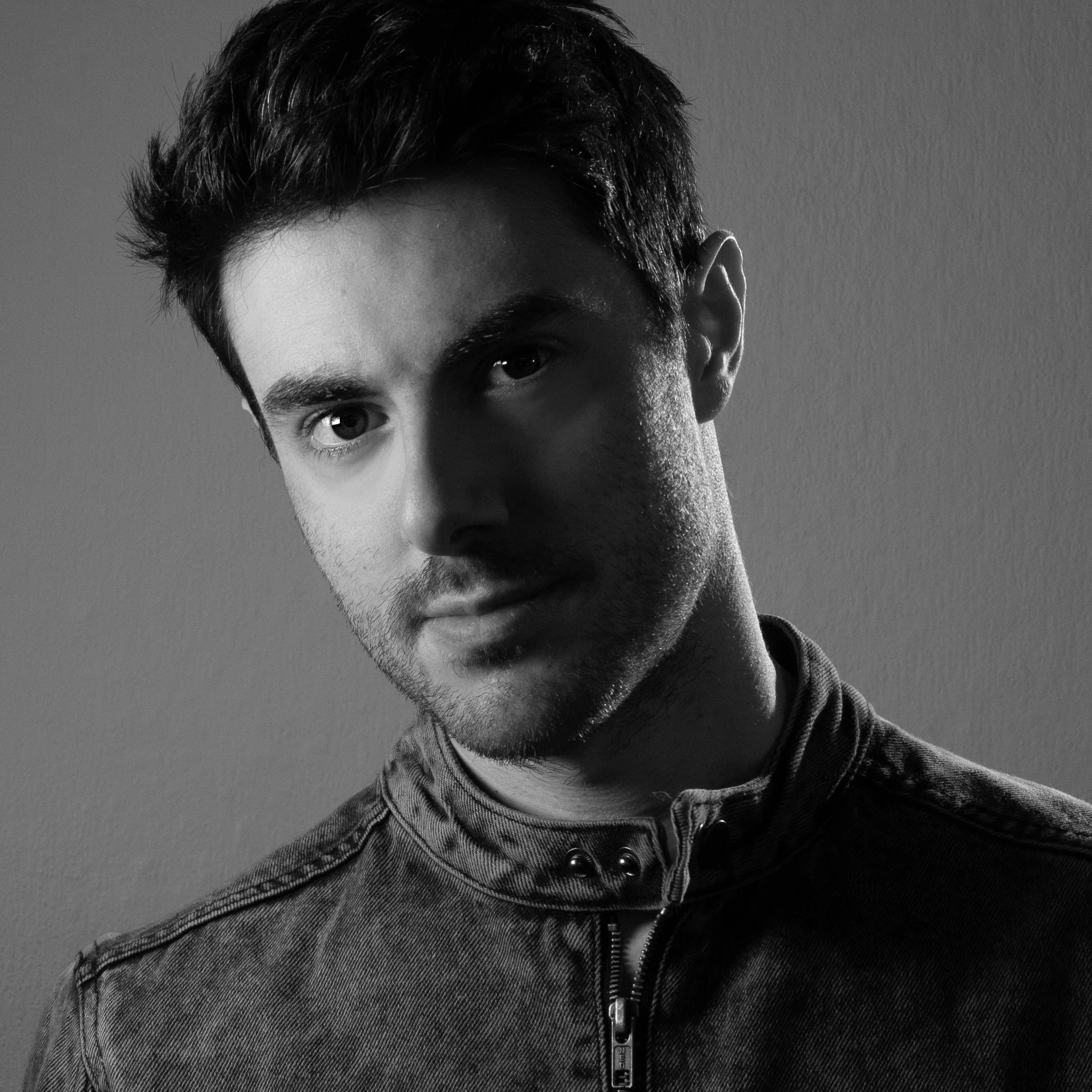TechRadar Verdict
With the Osmo Action 6, DJI cements its position as a real threat to GoPro’s dominance in the action camera market. Image quality is superb in bright light, and highly impressive after dark or in dimly-lit surroundings. The design is familiar if you’ve used its predecessors, but why change what is a great foundation to start with? Both screens are easy to work with, and are as clear as anything its competitors can dish up in real-world testing. The camera is uncomplicated, well built, and designed with a developing ecosystem in mind. The Osmo Action 6 is yet another step in the right direction for DJI.
Pros
- +
Larger 1/1.1-inch sensor
- +
Great image quality
- +
Impressive battery life
- +
Expanding modular system
Cons
- -
Aggressive in-camera processing
- -
Fiddly accessory attachment point
Why you can trust TechRadar
DJI Osmo Action 6: two-minute review
When you think of action cameras, GoPro will likely spring to mind before DJI. While it wasn’t a complete surprise that the latter company, best known for its drones, made the move into the action cam market, it's had to do a lot of work over the past few years to catch up, and offer something that stands out from the competition.
The GoPro Hero 13 Black is arguably the action camera all others will currently be judged against, so DJI’s latest model in the Osmo series, the Osmo Action 6, has a lot to prove. That said, the quality of its predecessors, most notably the Osmo Action 5 Pro, has been hard to ignore, and based on my experience with that camera I had great expectations going into this review.
Fresh from reviewing the entry-level GoPro Lit Hero and Insta360 X4 Air, I was immediately impressed by the Osmo Action 6’s user-friendliness; the menus are easy to navigate, and the screens are a breeze to work with. Images and video also look amazing on these high-quality monitors, so reviewing the fruits of my shooting sessions was a pleasure.
Image quality is superb, benefiting from a larger 1/1.1-inch sensor, which produces excellent detail and color rendition in good lighting and stand-out noise performance as ambient light levels fall. I’d happily use the Osmo Action 6 as my main carry-everywhere camera, or as a backup to a mirrorless system for capturing unique perspectives from places those larger cameras simply can’t go.

I thoroughly enjoyed using the additional accessories, such as the Macro Lens, ND Filter Set, and FOV Boost Lens, which make the whole system feel pro-grade and versatile. If you're a fan of the GoPro mods, you’ll be happy to see DJI making efforts to expand the modular compatibility of its action cameras. Once you add in the streamlined compatibility with the wireless DJI microphones, I see the Osmo Action 6 as an indicator of great things to come.
DJI Osmo Action 6 specs
Type: | Action camera |
Sensor: | 1/1.1-inch CMOS |
LCDs: | OLED, Front: 1.46-inch/ Rear: 2.5-inch |
Memory: | 50GB internal/ MicroSD |
Lens: | 155-degree FOV, f/2 - f/4 |
Video: | Up to 4K/120p, FHD/240p |
Photo: | 38MP |
Dimensions: | 72.8 x 47.2 x 33.1mm |
Weight: | 5.3oz / 149g |

DJI Osmo Action 6: Price and availability
- Released November 18; not available in US at launch
- Osmo Action 6 Standard Combo costs £329 / AU$669
- Osmo Action 6 Adventure Combo costs for £415 / AU$839
DJI's Osmo Action 6 is available now, priced at £329 / AU$669 for the Standard Combo, while the prices rises to £415 / AU$839 for the Adventure Combo which adds two batteries, an extra quick-release mount and locking screw, battery case and 1.5m extension rod to the standard bundle.
Like recent DJI products, it's not available in the US at launch. A DJI spokesperson gave us the following statement:
Sign up for breaking news, reviews, opinion, top tech deals, and more.
"The DJI Osmo Action 6 will not be officially available in the US market through official websites following the global launch on 18th November. DJI remains committed to the U.S. market and is optimizing our strategy to best serve our customers amidst evolving local conditions."
- Price score: 4.5/5
DJI Osmo Action 6: Design
- Larger 2.5-inch rear LCD
- IP68-rated weather and waterproofing
- Waterproof to 20m
If you’ve used the Osmo Action 6’s predecessors, such as the DJI Osmo Action 3 DJI Osmo Action 4, or DJI Osmo Action 5 Pro, there aren’t any drastic surprises in store for you design-wise. The body is a little bit larger, most notably in its width, measuring 72.8 x 47.2 x 33.1mm to the Osmo Action 5 Pro’s 70.5 x 44.2 x 32.8mm. It might be noticeable if you hold both cameras side-by-side, but in real-world terms it won’t make a huge difference to the handling experience.
The Osmo Action 6 remains super portable and lightweight, despite the inclusion of a larger sensor, which is impressive. As you’d expect from an action camera, it can be fitted into a coat pocket for easy transport or use on the move. However, fresh from testing the tiny GoPro Lit Hero, the Osmo Action 6 did feel quite chunky by comparison. This is a much higher-end product, however, featuring a larger CMOS unit, a lens aperture that's both adjustable and brighter, and a front LCD, all of which are missing from the entry-level GoPro.
I was immediately drawn to the 2.5-inch main LCD screen, which feels much bigger in use than the rival GoPro Hero 13 Black’s 2.27-inch monitor. Although this is still too small to get a truely precise idea of sharpness, it’s much nicer to look at than the screens on earlier models, and matches those on cameras like the Insta360 Ace Pro 2, which we ranked as the best premium action camera.

The screen itself was highly responsive in my tests, and I found it easy to access settings and navigate menus, even when the camera was wet or covered in a dusting of ground coffee (see the sample video below for context). I reckon I’d find it more practical to work with the Osmo Action 6 in cold weather than the native-portrait-orientation Insta360 X5 or Insta360 X4 Air.
Both the front and rear LCDs are crisp and easy to read in brighter light too. While smaller and lower-resolution, the front screen (1.46-inch, 342 x 342 pixels) is still useful, and doesn’t feel like an extra gimmicky feature that DJI threw in but which is ultimately pointless. I remember feeling that the front LCD on the GoPro Hero 9 Black was so laggy that there were times it was barely worth being there, for example.
The large shutter release is easy to locate without looking, speeding up operation. Also, I like DJI’s choice to place the microSD card slot in the battery bay, rather than alongside the USB-C port, something which proved fiddly and frustrating on the GoPro Lit Hero. I always appreciate integrated storage in a camera too, of which the Osmo Action 6 provides plenty at 50GB.
- Design score:4.5/5
DJI Osmo Action 6: Performance
- Impressive four-hour battery life
- Effective RockSteady 3 and 3+ stabilization with reduced cropping
- Excellent connectivity with external DJI mics
DJI claims a battery life of 240 minutes for the Osmo Action 6, similar to the Action 5 Pro. Shooting inside and out, I found that a single charge lasted about four hours using a mix of 1080p and 4K resolutions, across the various modes. This is impressive, although as the temperature dropped, so too did the battery life, so if you plan to work away from a power source for any length of time I’d still advise taking a few extra batteries.
The RockSteady image stabilization system also has an impact on battery longevity, although in my tests, this wasn’t anything major. The system itself is effective. While not a replacement for a gimbal, I found I could create commendable tracking shots free from micro vibrations. The same was true with POV walking shots.
The Osmo Action 6 continued to perform well after being submerged in water, with the screen remaining responsive. Once it was removed from the water the lens quickly repelled remaining droplets, as did the body, making the camera easy to dry off.


The camera features voice control, which is either ideal or an irritation depending on the environment. When it worked, being able to give the Osmo Action 6 a voice command such as “start recording” helped free up my hands, while reducing the amount of footage I had to trim as I positioned the camera for my shots. On several occasions, it didn’t respond, or I didn’t realise it hadn’t stopped recording after a command at the end of the shot. If the microphone is obscured in any way, it produces mixed results.
Speaking of sound, I was surprised by the quality of the internal microphone. While an external mic like the DJI Mic Mini gives you more versatility, as well as depth of audio, the built-in mic didn’t have the thin sound common to similar mics on other small cameras.
If you own the Mic Mini or DJI Mic 2, connecting them to the Osmo Action 6 couldn’t be easier. Simply pressing and holding the link button on the mics themselves until the indicator light flashes blue is all it takes to get audio recording off-camera, giving video that extra professional edge.
- Performance score: 4.5/5
DJI Osmo Action 6: Image quality
- Larger sensor enables better low-light performance than Osmo Action 5 Pro
- 10-bit and D-Log M modes enable pro-level grading
- Slightly aggressive default in-camera noise reduction/sharpening
Along with smartphones, I think that action cameras best demonstrate how far sensor and processor technology have come over the past decade or so. By mirrorless camera standards, the 1/1.1-type sensor housed in the Osmo Action 6 is small, at around 14mm on the diagonal, yet in my testing it produced better results than a high-end compact camera from circa 2014.
The Osmo Action 6 sees a big jump in sensor size from the 1/1.3-type CMOS of the Action 5 Pro, but uses a similar resolution of 38MP for still images.. This allows for greater pixel pitch (the distance from the center of one pixel to its neighbors), which benefits light-gathering capacity; the pixel size is 2.4 micrometers. An image measuring 7168 x 5376 is still quite a lot of pixels for this sensor format, but while I wasn’t amazed by the camera’s low-light performance, nor did I find it especially problematic.
Detail in stills becomes a little smudged from around ISO 800 and above, shooting in gloomy indoor lighting, but outdoors, or in direct artificial light, noise levels are kept at respectable levels for an action camera. Colors are also still quite punchy.
Video footage, meanwhile, is excellent in moderate low light. There is noise visible, but the grain size looks very fine, meaning it’s easier to ignore in areas of the image containing flat tones. I thought in-camera processing coped well, minimizing noise without obliterating texture.

I did notice that some quite excessive sharpening is applied in some circumstances, no doubt to counteract any noise-reduction related degradation. It isn’t a deal-breaker, but you might want to turn down the default sharpening (known as Texture in the Image Adjustment menu) for a more organic look.
The SuperNight mode is designed to produce a brighter image in low-light conditions by increasing the exposure digitally, then applying AI noise-reduction processes to minimize grain. This produces footage with significantly less texture, so I wouldn’t recommend it if your video is likely to be viewed on a larger screen, where this effect will be far more noticeable. In everyday shooting scenarios, or for social media, however, it captures brighter shadows, so it's useful for shooting around cities. There's a lot less distracting noise, too.
I enjoyed using the Slow Motion mode as a means of capturing share-ready footage in-camera; however, for professional uses, I’d recommend switching to a higher frame rate, shooting your footage, and manually applying the Slow Mo effect in editing.
I really appreciated the Color Recovery feature when shooting in D-Log M, which allows you to preview how the footage would look with a profile applied. This doesn’t bake in any edit settings, but merely gives you an idea of the final image after grading.
All of the shooting conditions mentioned above would be challenging for any camera, and once you take the DJI Osmo Action 6 out into bright daylight, the quality is superb. Combined with the flexibility of the Log mode, it’s possible to capture excellent levels of detail and natural colors.
GoPro Hero 13 Black users might bemoan the ‘limited’ 4K resolution here, in favor of the 5.3K available on that model, but 4K is fine in all but the most specific of situations. I still shoot in Full HD as standard when creating content for social platforms, unless I know that for some reason I’ll need to crop or recompose my frame in DaVinci Resolve. The workflow is faster, and viewers are unlikely to perceive a difference in Instagram Reels or YouTube Shorts, for instance.
- Image quality score: 4.5/5
DJI Osmo Action 6: testing scorecard
Attributes | Notes | Rating |
|---|---|---|
Price | Considering it's technically an upgrade to the X4, the X4 Air is significantly cheaper, which is welcome. There is the matter of the DJI Osmo 360, though. | 4.5/5 |
Design | Everything is logically placed and the controls are easy to access. It's a proven design that continues to work well for DJI. | 4.5/5 |
Performance | The LCDs are responsive and attractive, while the RockSteady stabilization system is highly effective. | 4.5/5 |
Image quality | Yes, there may be no 8K, but 4K and FHD footage is sharp, clean, and punchy. The larger sensor is doing its job, and the Osmo Action 6 is a great competitor to the GoPro Hero 13 Black. | 4.5/5 |
Should I buy the DJI Osmo Action 6?
Buy it if...
You aren't married to GoPro
<p>While it makes sense to stick to GoPro if you already own plenty of mods, the Osmo Action 6 represents the direction DJI is heading with its action cameras, and there's plenty to like.You want high-end imagery
<p>There are a lot of features and functions to play with, so a pro user will find something for every shooting occasion. Make the most of the low-light performance and slo-mo functions for advanced projects.Don't buy it if...
You want a simple camera
<p>The camera is designed for experienced videographers, so all of those features and functions might prove to be intimidating if you haven't used them before. There might be too much here if you want a point-and-shoot model.You have lots of GoPro accessories
<p>DJI is hoping to build its own follower base, so it you already own and frequently use GoPro mods, across an advanced system, you might not want to start from scratch with an incompatible camera. There are currently fewer accessories in the DJI ecosystem too, which is worth bearing in mind if you need something specific.Also consider
The top-of-the-range model in the Insta360 family, the X5 is larger but more powerful. It enables recording up to 5.7K at 60fps, and features dual 1/1.28-inch sensors with larger pixels and greater light-gathering capacity. It also features the newer PureVideo mode that's missing on the X4 and X4 Air, providing superior performance under poor lighting. The build quality and control layout are familiar, but with the added benefit of a larger LCD. If you want to shoot 360-degree video as well as shooting in extreme conditions, this is the best option.
Read our in-depth Insta360 X5 review
While it may have only been an iterative upgrade to its predecessor, the Hero 13 Black is built on an expansive system of accessories. You'll find a mod for every occasion, plus there's a higher-resolution 5.3K video option, while the Osmo Action 6 is limited to 4K. This is the enthusiast's go-to action camera.
Read our in-depth GoPro Hero 13 Blackreview
How I tested the DJI Osmo Action 6
- I tested a full production model running release firmware over several days
- I mounted the camera on the bundled 1.5-meter extension Rod or Dual-Direction Battery Handle
- I recorded videos in varying lighting conditions, both indoors and outside
To ensure I was able to get a true sense of the Osmo Action 6's capabilities, I shot in a range of lighting conditions. My indoor tests involved a vlog-style shoot, testing the sensor's high-ISO performance and the camera's temperature and water resistance (I placed the camera in a freezer and poured cold water over it for a unique POV). I then took the camera out into the countryside, where I filmed close to and underwater. These shoots also gave me the opportunity to use the optional macro lens and FOV Boost lens. All audio was captured using the in-camera mic. Footage was edited in DaVinci Resolve 20.
- First reviewed November 2025

Peter is a photographer, writer, and journalist who served as Editor for Digital Photographer Magazine, working on the title for 8 years.
You must confirm your public display name before commenting
Please logout and then login again, you will then be prompted to enter your display name.
